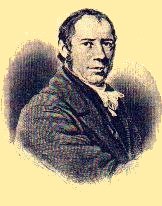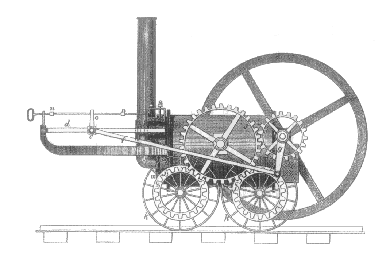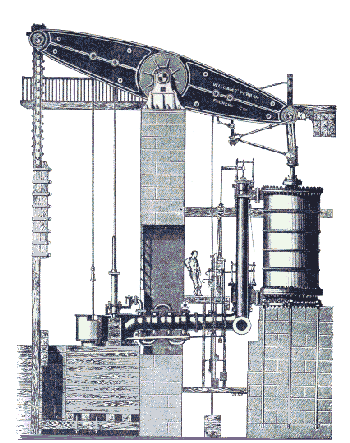


Web: www.trevithicksociety.info
The first horseless carriages were steam driven. Vehicles built by William Murdoch and Richard Trevithick ran on Cornish roads about a hundred years before White and Stanley steamers were seen in America. Murdoch displayed his model steam carriage at Redruth in 1792 but it wasn't until 1801 when Trevithick's four wheeled vehicle was driven by high pressure steam from a horizontal cross flow boiler, fitted with a safety valve that the world saw something which looked like a workable automobile. Trevithick was also the first man to put a steam locomotive on rails.
The Cornish mine owners of the 18th century sought no engineering qualifications as we would know them. Every day was an adventure and discoveries were being made all the time. 'Engineers' or 'Captains' of mines achieved their positions by being resourceful, good at their jobs and being able to influence both their superiors and inferiors. Richard Trevithick was greatly influenced by his father, also Richard, who was Captain of at least four major mines. Trevithick, Senior, was well known for his skill and knowledge of mining. He accompanied a deputation of mine owners to Birmingham in 1776 to inspect and find out as much as they could about the latest Boulton & Watt steam engines (then known as 'fire engines').
Richard Trevithick was born at Illogan on April 13th 1771, son of the manager of Dolcoath Mine. He was the only son in a family which included 5 sisters; he was his mother's pet. His mother was miner's daughter Ann Teague (died 1810). His father, Richard Trevithick senior, was already well known in the local mining community and was a pious Methodist whose friends included the preacher John Wesley. He lived at Trevithick Cottage, Penponds for most of his life from childhood in the 1770's before marrying Jane Harvey (daughter of John Harvey) in 1797. They raised six children. Although his work often took him away across the River Tamar and overseas, Trevithick returned to his cottage when he was in Cornwall.
Much of Richard's character can be traced to his distinctive upbringing. His school master reported him frequently absent, disobedient and spoiled although he did demonstrate a precocious aptitude for mental arithmetic; albeit by methods known only to himself. In later life he could be impatient and obstinate, sometimes to the point of selfishness, when others disagreed with his theories and methods. Yet his Methodist roots made him humble and generous in more spiritual matters and he pursued his numerous projects with a tireless enthusiasm that left his contemporaries behind.
In physical stature Trevithick was as remarkable as his reputation. At six foot two inches he was uncommonly tall for his time, especially among his Cornish compatriots. His huge frame was topped by a large head with a kindly face and big blue eyes. Trevithick was an accomplished Cornish "wrastler" and his feats of physical strength were legendary among the locals; such as the time he threw a sledgehammer clean over an engine house roof. Some said it never came down! Trevithick is most popularly associated with the steam locomotive. He did not invent the first self-propelled vehicle but he was the first to put one on a railway track. His most important contribution was the adoption of high-pressure steam which powered his locomotive engines. His remarkable career began in his native Cornwall; among the principal tin and copper mines around Camborne and Redruth.
Throughout the 18th century the need for mines to go deeper was resolved by the invention of the steam engine. Any mine needs drainage and in 1720 Thomas Newcomen erected the first steam engine in Cornwall in Ludgvan Lez near Penzance. Boulton and Watt erected the first of their much improved models, with the separate condenser, at Wheal Busy, Chacewater in 1778, with the engineer John Smeaton also involved. By 1780, 20 of these engines were at work in Cornwall.
Watt's engine was powerful, more reliable and 3 times more efficient than the Newcomen model. Mine owners had to pay a royalty to the Boulton and Watt company; a charge equivalent to a 3rd of the financial saving (based on coal consumption) and clever use of the patent laws prevented further improvement and alteration of the steam engine until the turn of the century.
John Harvey's first involvement with the Trevithicks was in 1775, when he was employed by Richard Trevithick senior (1735-1797) as part of the team installing a second-hand Newcomen engine at Dolcoath Mine, where Trevithick was mine captain.
Trevithick first appears working at East Stray Park mine near Camborne in 1790 and then as a consultant engineer at Tincroft in 1792. Many Cornish mine owners begun to resent the expensive royalty payments to Boulton and Watt and Trevithick became involved in attempts to avoid the separate condenser patent. Watt eventually succeeded in serving an injunction on Trevithick to curtail his activities in 1796 but in 1800 the patent expired and Trevithick's genius was allowed to flourish. A report in the Boulton and Watt papers records Trevithick's mood after he had received the injunction.
"Trevithick walked backwards & forwards in the house like a mad man and firmly resisted all temptation to dinner, till the smell of a hot pot overcame his powers, on which he set to, & did pretty handsomely, but in such a manner as showed him not quiet in mind. The rejoicing that was going going forward at the very door, exhibited by fires and gunpowder work, not a little contributed to his happiness while he stayed which was for a very short time indeed. They posted off towards Colebrookdale. "
In 1797 Trevithick married Jane the daughter of John Harvey his boiler maker of Hayle. They raised six children. About this time he also began experimenting with high-pressure steam whilst working as an engineer at the Ding Dong Mine. Watt had considered this too dangerous but Trevithick's models (stationary and locomotive) demonstrated increased power and, what's more, avoided the Watt patent by the removal of the separate condenser. Instead the steam was exhausted directly into the atmosphere and Trevithick's "puffers" were soon at work probably winding ore at Dolcoath. The linear motion was directly converted into circular motion via a crank instead of using a more cumbersome beam.

Trevithick completed his first full sized road locomotive (named Puffing Devil) in 1801. He demonstrated it to the public on Christmas Eve with his cousin Andrew Vivian at the controls. It successfully carried a number of men up Beacon Hill, an event commemorated by the old Cornish song "Going up Camborne Hill" and marked by Trevithick's statute which stands outside Camborne library, gazing up the hill in question. The engine ran at forty piston strokes a minute, with an unprecedented boiler pressure of 145 psi. The high-pressure vehicle was patented on the 24th March 1802. It was Trevithick's first patent. By 21st February 1804 Trevithick had the first locomotive up and running at the Penydarn ironworks in South Wales. It travelled over 9 miles at a speed of 5 mph, pulled a 10 ton load, 5 wagons and 70 men. It was an historic moment. Another ran on a circular track off Gower Street in London in 1808 (near the present day Euston Station). Trevithick charged one shilling for a ride on the "Catch Me Who Can" but the idea never caught on. 21 years later his friend George Stephenson won The Rainhill Trials with 'The Rocket!'.
However, Trevithick's engine was a machine of universal application and his ability to put high-pressure steam to various uses was another mark of his genius. While contracted to work on the Thames Driftway (a tunnel under the river) Trevithick proposed and patented high-pressure engines for a "Nautical Labourer" (steam tug and floating crane) and a Steam Dredger in 1808.
When, in September 1810, sickness and bankruptcy forced him and his family to leave London and return to Cornwall he continued to develop new machines starting, in 1812, with a rotative agricultural engine for thrashing corn, the plunger-pole high-pressure engine and the recoil engine. These and other ideas were all patented in 1815. Trevithick also became involved with the St. Ives and Plymouth breakwater schemes at this time.

Trevithick made his most important contribution to Cornish mining with his work on the Cornish engine and boiler in 1812. The boiler was cylindrical and horizontal with a fire tube passing down the middle. This innovation increased the mechanical and thermal efficiency and the safety by surrounding the fire with water. Coupled with the high-pressure engine Trevithick could claim to double, sometimes treble, the duty of any Watt engine. In 1820 he worked with Samuel Grose to erect a high-pressure engine at Wheal Prosper. Soon Cornish engines were in use all over the world.
Michael Williams, MP, a contemporary of Trevithick, once said of him; "he was the greatest and worst used man in the country." Trevithick never received the riches he should have done during this period. Many have pointed at his lack of business acumen and the absence of a Matthew Boulton type partner. It was for this reason that he left England in 1816 on a South American adventure among the silver mines of Peru.
During this time Don Ricardo also speculated in Costa Rica, became the first European to cross the Isthmus of Nicaragua and was drafted to fight for Simon Bolivar. Needless to say this romantic adventure also ended in financial catastrophe and Trevithick arrived back in England, penniless, in October 1827. He had been gone from his family for over ten years.
Trevithick's wife Jane stood by her genius husband, looked after their children, accepted all his moods and went to live with him in London. During his absences she turned to her family for assistance and they built Hayle's much needed hostelry The White Hart for her to manage.
It is hard to document the life of Richard Trevithick and do justice in so short a space. Such was the scope of his life's work that we can only do touch on it here. In his later years Trevithick continued to submit a plethora of mechanical ideas for patent and, at one time, was contracted to the Dutch government on a land reclamation and drainage scheme in the lowlands.
In 1832 he proposed a 1000 foot high, cast iron column, in celebration of the Reform Bill but the government did not accept the idea. Neither did they accept his petition to Parliament, entrusted to his friend Davies Giddy, MP, (who took the name Gilbert) seeking reimbursement for services rendered to the nation. In 1829 he built a closed cycle steam engine followed by a vertical tubular boiler. On April 22nd 1833 Trevithick died after a short illness in Kent, he was 66. He was penniless and laid to rest in a pauper's grave in Dartford churchyard. No stone marks the spot. In a last letter to Giddy, some months before his death, it is possible to read the thoughts of a man who perhaps feels he is near the end There is a statue to him in Camborne, outside the public library, holding a model of his locomotive. There is also a memorial window to him in Westminster Abbey. As a celebration of his life and achievements (Trevithick Day) is held every year at Camborne.
In Camborne, outside the Public Library, a statue by Leonard Stanford Merrifield depicting Trevithick holding one of his small-scale models was unveiled in 1932 by Prince George, Duke of Kent, in front of a crowd of thousands of local people.
A replica of Trevithick's first full size steam road locomotive was first displayed at Camborne's Trevithick Day in 2001.
The Trevithick Society, a forerunner of Industrial Archaeology organizations that was initially formed to rescue the Levant winding engine from being scrapped was named for Richard Trevithick. They publish a newsletters, a journal and many books on Cornish engines, the mining industry, engineers, and other industrial archaeological topics. There is also a street named after him in Merthyr Tydfil.
Trevithick Cottage Trevithick Day Famous Cornish People Cornwall's Railways East Pool Mine
King Edward Mine Museum Mining in Cornwall Cornwall's History South Crofty Mine